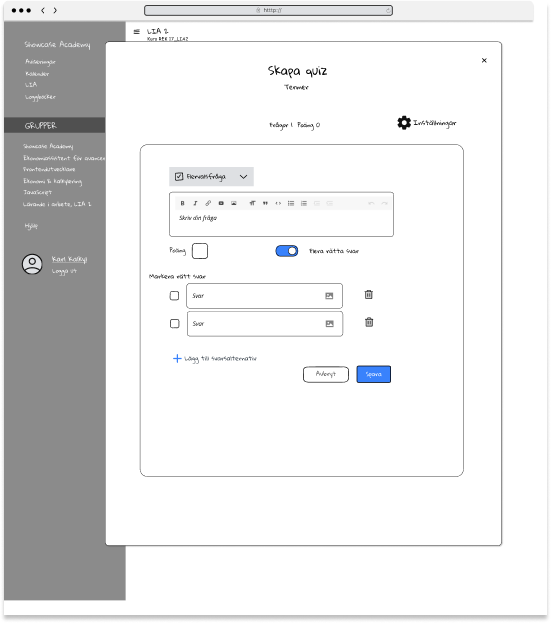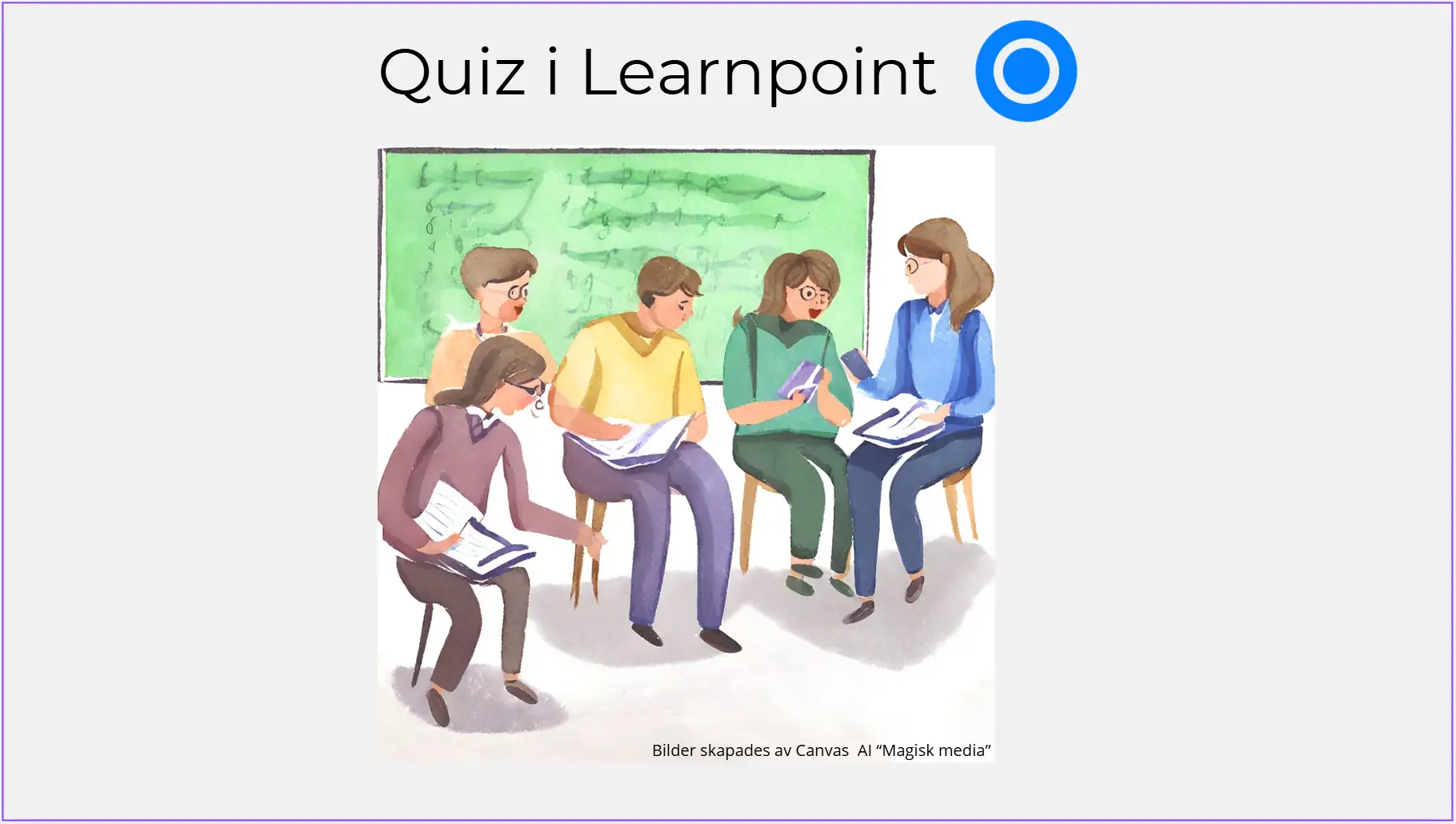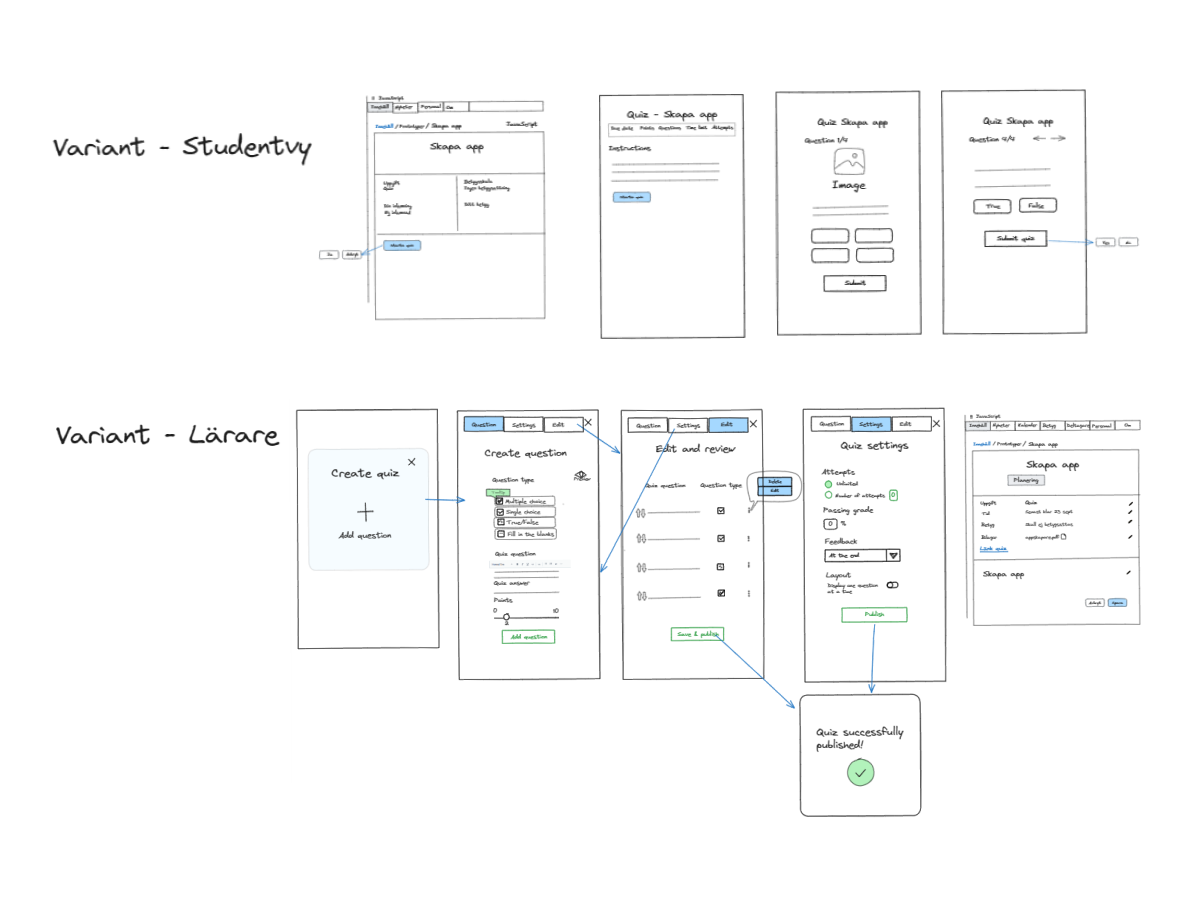Quiz function implementation
The Task: Research on Quiz function implementation in existing LMS learning management system in Learnpoint.
Learnpoint is (SaaS ) (B2B) platform who offers Learning management system to Yrkes Högskolor.
Project Goals: User Research + Prototyping + Testing + Presentation to the company and stakeholders.
Team Members & Collaborators:
Cros My My role – UX designer group project under LIA. We had same roles because of learning goals to get and exchange the same experience and develop skills.
Results
- Reducing Development Costs and Time
- Enhancing Competitive Advantage
- Boosting Brand Loyalty and Perception
- Supporting Business Goals

Problem
- Customers have expressed wishes for a quiz tool that would enable variation in teaching as well as a motivational factor.
- To make LMS more competitive against other market competitors.
- Increase their product value with help of updater tools.
- Quiz that can be linked to a point system and can be used as a survey in the future.
- For complicated settings.
- Quiz that costs.
- Points systems that are difficult to administer and not flexible enough.
- Get a few question types.
Solution
Goals:
- Quiz Included in existing LMS.
- Logical, consistent, intuitive settings.
- The points system must be easy to administer and change if necessary and linked to the school’s existing grading system
- Several different question types and the possibility to add images or videos.
- Start with most necessary features in MVP and plan next realize
- Combine some futures together
- Make Quiz function usable on mobile
- Plan how it is possible to use as assignment and survey in the future.
Final Design
User research
Stackeholders interview
We started with stakeholders interviews to understand business needs and goals. Why do they need to implement a totally new future such as Quiz in the (LMS) Learning Management system?
And the question that followed all along the process: what is a good Quiz?
User Research with Interviews with Teachers who are the main users. And conducted two Surveys one for the student another for Teacher. 3 Intervju with the teachers, one of them had experience making her own Quiz program because could not find a Quiz program that matched their needs.
Market research
Competitive Analysis/Competitive Usability Evaluations
To get started and start exploring opportunities, we analysed the competition, both within LMS platforms and external tools.
We carried out tests with different quiz tools and then focused on factors such as ease of use (learnability and memorability), the time it took to create quizzes, as well as the time it took to understand and become familiar with the tools.
However, we ourselves did not represent the end users. To get real insights from potential users, it was necessary to interact with teachers directly.
Problem Statements
Pain points
- For complicated settings.
- Quiz that costs.
- Points systems that are difficult to administer and not flexible enough.
- Get a few question types.
Goals
- Logical, consistent, intuitive settings.
- Quiz Included in existing LMS.
- The points system must be easy to administer and change.
- Point system Linked to the school’s existing grading system.
- More different question tipes in future.
User Stories mapping (MVP)
Provides Better Planning for Feature Releases.
Ensures the final product is tailored to the users, improving usability and user satisfaction.
By prioritizing user stories and visually mapping them out, teams can plan product features and their release timeline more effectively.
Ultimately, it leads to a more successful product that meets both business goals and user expectations.
Value Proposition Canvas
Aligning Product Offering with Customer Needs.
Ensures that the product or service will resonate with the users, making it more likely that users will adopt it and become loyal customers.
By understanding the user’s jobs, pains, and gains, and mapping these to the product’s features, we can create more relevant, user-centered experiences.
Sketching
Under market research we did alot of sketches Freehand sketching it is a fast, flexible, and low-fidelity way to explore design ideas.
Saves time and reduces the mental effort needed to create polished designs.
Allows for quick changes and refinements, reducing the risk of investing too much time on an idea that might not work.
Prototyping
Usability Testing
Usability Testing:
- Testing with the design team
- Support team feedback
As UX designers, our core principle is to put the user in focus. We aimed to conduct user tests with the actual target audience, but had limited access to testers. Instead, we used the next best option: Learnpoint’s support team. After years of communicating and helping users, they have developed a deep understanding of what works and what doesn’t. Their insights were important to us in shaping our design process.
Iterative Testing and Feedback Loops – they should continue themselves with iterations and implementation.
Presentation

Next step
Handoff and Communication:
- Prepared design specifications, user flows, and interactive prototypes for the development team.
- Conducted handoff meetings to ensure clarity on functionality, accessibility (WCAG compliance), and responsive design requirements.
The team will continue with translating the tested prototype into a fully functional quiz feature within the Learnpoint (LMS). This involved close collaboration between UX designers, developers, and stakeholders to ensure the solution aligned with user needs, technical feasibility, and business goals.
Learnings
Empathy for Educators and Learners
Through user research and feedback sessions, I developed a deeper understanding of the unique needs of educators (e.g., ease of setup) and students (e.g., clarity and engagement), which strengthened my ability to design intuitive, user-friendly interfaces.
Outcome-Driven Design
By analyzing the impact of the implemented feature, such as the increase in quiz completion rates, I learned to connect design decisions to measurable outcomes, enhancing my focus on delivering value to users and the business.
Problem-Solving and Adaptability
Collaborating on the quiz feature taught me how to adapt quickly to challenges, such as balancing design goals with technical limitations, and finding innovative solutions without compromising user experience.





